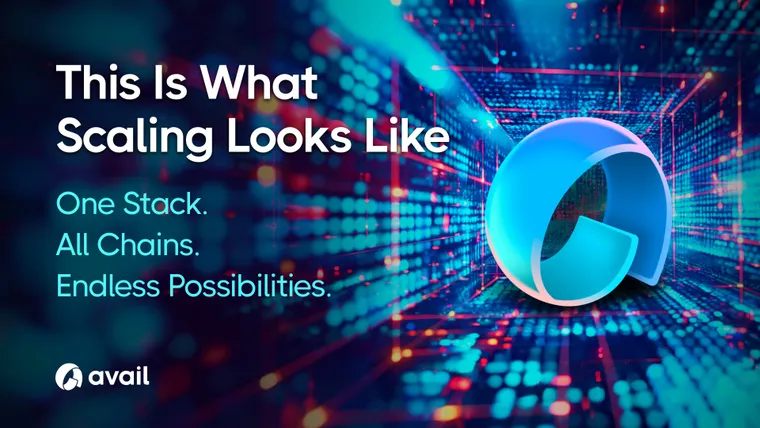In the early days of modular blockchains, decoupling execution from data availability (DA) was radical. Most chains were monolithic, bundling consensus, execution, and storage into a single, inefficient stack (circa 2021).
At Avail, we saw that the future demanded a more scalable and highly efficient stack.
We started with a simple but profound insight: to scale L2s, rollups and appchains, you must first scale data availability itself. Not just bigger blocks but verifiable, secure, fast and decentralized DA that could underpin an entire ecosystem.
In July 2024, we launched Avail DA, a purpose-built layer for cost-efficient, scalable, and verifiable data availability. The ecosystem quickly grew with major mainnet clients including Sophon, Lens, Space & Time, Rooch, SOON, Odysphere, Skate, Up and Down, Starknet, Eternal and a healthy pipeline of dApps on them, with 50+ more chains integrating within the next 12 months.
As rollups proliferated, new challenges became obvious. Liquidity was fragmenting with each new chain popping up. Bridges were brittle. Users were tired of the UX complexities, and this was preventing mass adoption. Developers were rebuilding the same coordination logic over and over on each chain they deployed on. Exhausting! And composability, the golden promise of crypto, was slipping into an abyss.
The Avail vision has always been to broaden the Avail Stack to bring in new functionality and upgrades that would enable the chains on Avail to build and scale horizontally.
The Avail Stack is designed to create a network where everything would connect verifiably, securely, and efficiently; all while remaining within the core blockchain tenets, like decentralization and permissionless nature.
From Mainnet to Now
Over the past year, Avail has quietly evolved into a horizontally scalable, verifiable infrastructure stack enabling rollups to scale, connect, coordinate, and thrive in one seamless network.
Every addition to the Avail Ecosystem was shaped by direct conversations with rollup teams, infra providers, and application developers. We weren’t guessing what the future needed, we were building it with the people shaping it.
We introduced:
- Turbo DA: A high-throughput, low-cost upgrade to our base DA layer, built for rollups at scale. It allows preconfirmations with a speed of 250ms and the ability to pay for fees in native tokens.
- Enigma DA Upgrade: The first ever privacy-preserving encrypted DA for institutions seeking to build private applications without compromising on the benefits of public blockchain networks whilst being regulatory compliant.
- Light Clients: Enabling permissionless mobile-first decentralization, enabling end user verification. Major players like Sophon adapted Avail Light Clients to play a key role in its $60 million node sale.
- ZK Execution Runtime: Avail supports any execution environment with native ZK verification on the base layer.
- Infinity Blocks (coming soon): Hyper-scale with 10GB blocks with a 600ms block time. Ideal for high-volume, real-time industries like gaming, social media, AI, etc.
- Fusion Upgrade (coming soon): Fusion lets apps and rollups borrow security from a shared pool of staked assets, like AVAIL, ETH, BTC and any ERC20 tokens, so they don’t need to bootstrap initial liquidity.
However, the real shift came with the Avail Nexus Upgrade.
The Nexus Effect… A Turning Point
The launch of Avail Nexus marks a new phase in blockchain evolution, one where chains no longer operate in silos, and users no longer face the friction of fragmented ecosystems. Nexus is a trust-minimized network layer that enables native cross-rollup and sovereign chain communication, unlocking shared liquidity, shared infrastructure, and a unified user experience across the modular Web3 stack.
Real Use Cases: Liquidity, Interop, and UX That Just Works
Nexus directly solves a fundamental challenge for emerging rollups and appchains: the lack of relevant infrastructure and native liquidity. When a new chain launches, it often doesn’t have AMMs, money markets, or oracles live on day one. But with Nexus, that’s no longer a blocker.
Let’s take an example: Sophon, a chain built on the Avail Stack, does not have Uniswap deployed. But Lens, another chain in the Avail ecosystem, does. Through Nexus, a Sophon user can access Uniswap on Lens without leaving the Sophon app, without bridging assets, and without switching wallets or networks.
All the underlying interactions, bridging, swapping, messaging, are abstracted away in the backend with Avail Nexus. The user stays in the same front-end app, simply approves the transaction in their wallet, and the action is executed behind the scenes. The result is returned directly to the user on Sophon still within their app, as if everything happened natively. This transforms the typical 12+ click, multi-step flow into just 3-4 simple clicks.
If any one chain in the Avail Stack has access to a dApp like Uniswap, Aave, or any defi primitives platform, then every chain in the ecosystem can access it too, as if it were within the same network. It’s not just shared liquidity, it’s shared execution and shared infrastructure.
The Nexus Effect…
Nexus unlocks powerful new design patterns for application developers:
- New chains can bootstrap liquidity immediately from connected ecosystems without deploying all infra on a new network.
- Developers can build multichain applications that coordinate state and logic across environments without replicating contracts.
- Users get a seamless in-app experience with no network switches, no bridges, no leaving the app, no waiting periods.
Under the Hood: The Tech Behind Nexus
Behind this smooth UX lies a breakthrough set of technologies that transform how chains communicate and coordinate:
- Liquidity Pools: Users get faster transactions with liquidity pools and solvers fulfilling orders quickly.
- Proof Aggregation: Avail aggregates execution proofs into a single zero-knowledge proof, enabling verifiable crosschain state updates.
- Modular Runtime: The Nexus Core manages proof verification, state tracking, and messaging. It includes connectors for EVM, ZK, Optimistic, and sovereign chains, making it easy for any environment to plug in.
- Fast Messaging Channels: The system supports both low-latency, intent-based routing for fast actions and state-root-based messaging for maximum cryptographic guarantees.
- Composable Multichain dApps: Developers can now deploy single smart contracts that span multiple chains, sharing logic and coordinating execution with no need to replicate infrastructure.
It’s not just shared liquidity, it’s shared infrastructure.
The Avail Ecosystem: Proof of Adoption
Product launches don’t just measure the growth of Avail; it is also reflected in the caliber of projects choosing to be with us in our journey. In the past six months, some of the sharpest minds and most ambitious projects have aligned with Avail. These partners span multiple verticals: social, ZK rollups, modular infra, institutional data, and restaking.
Among our first wave of ecosystem partners:
- Lens: Lens Chain, a ZK‑powered SocialFi L2 built by the team behind AAVE, uses Avail DA as its core data infrastructure. Since launching in April 2025, Lens Chain has migrated 650K user profiles, 28M social connections, and 12M+ posts. This is more than theoretical infrastructure; it’s real SocialFi at scale, stitched to Avail’s DA backbone.
- Sophon: Sophon is the first zk‑validium on Ethereum, built atop the ZKsync stack. It is the first validium to verify data attestations on Ethereum and uses Avail’s Light Clients as its data availability backbone. Sophon raised $60 million via a node sale in 2024, then, in just two months post-launch, supported by Avail Light Clients, they processed over 80 million transactions, with 23 live applications and growing. This demonstrates user-level adoption and cost-efficiency by posting rollup data to Avail daily, with accumulation topping 12.75 GB by May, at a tiny fraction of Ethereum costs. Sophon’s integration showcases Avail’s strength in supporting consumer-scale validiums powering real transactions, generating real traffic, and securing real funding, all via efficient, secure data availability and decentralization tools.
- Space and Time: S&T has integrated Avail DA to underpin its decentralized data analytics platform on the SXT chain. This foundation enables verifiable offchain data storage and querying for Web3 applications. By anchoring data proofs to Avail, they offer institutional-grade reliability for dashboards and reporting systems. They’ve partnered with Google Cloud, integrating their “Proof of SQL” ZK-verification layer into BigQuery, allowing developers to run tamper-proof queries on enterprise-scale data. Space and Time also brings verifiable compute to AI and blockchain use cases.
- Lumia: Lumia is building a decentralized cloud and AI infrastructure with a focus on tokenizing real-world assets (RWAs). Growing global projections suggest the tokenization market could reach anywhere from $10 trillion to $16 trillion by 2030. Avail DA and Enigma Upgrade equip Lumia to securely store, verify, and compute on tokenized deeds, commodities, real estate, and financial products, positioning both Avail and Lumia to capture a meaningful portion of a multi-trillion-dollar emerging market.
And many more, including SOON, Odysphere, Rooch, Carv, AIDX, are all on Avail. This is just the beginning. We’re on track to onboard over 50 new projects, spanning L2s, L3s, DeFi, crosschain infra, Web2 institutional giants and next-gen applications that wouldn’t be possible with existing architecture. By abstracting away the user journey complexities and performing all of the difficult aspects behind the scenes, connecting different dApps, chains and ecosystems for a seamless crosschain experience and nurturing liquidity, we will build a robust new blockchain world with the Avail Stack.
AVAIL Token: Where Things Stand
The AVAIL token is not just a simple infra token; it is a full utility token. And unlike other infra tokens, the AVAIL token will be deeply embedded across the stack:
- DA fees
- Validator fees
- Sequencer and interop fees
- Crosschain messaging and SDK fees
- MEV capture and redistribution
- Staking rewards from partner ecosystems with Avail stakers (earning between 8-12% APY)
- Partner rewards and ecosystem airdrops
As adoption grows, AVAIL becomes the fuel and the reward layer for the entire economy built on top.
Build Once, Scale Everywhere
The vision is simple.
One integration. Universal scale.
Build once on Avail, and your app, chain, or rollup instantly becomes part of a connected, interoperable, and verifiable network.
- Developers don’t rebuild logic for every VM.
- Users don’t juggle tokens, multiple wallets or bridges.
- Rollups get access to shared security and liquidity from day one.
And as Avail Fusion goes live, we unlock even more: restaked security, shared sequencers, and novel MEV capture, all verifiably coordinated using the Avail token and with fees going back to stakers.
Why Avail Is Built to Lead
- Most decentralized DA protocol (Nakamoto Coefficient: 35)
- $75M backing (Founders Fun d, Dragonfly)
- 40 GB+ data posted, 90% MoM growth
- 10 live partners, 50+ incoming
- Ethereum-aligned and ready for institutional use cases. Connecting various ecosystems, including Bitcoin, Ethereum, Solana, etc.
- Team: seasoned blockchain tech founders (led by ex original co-founder of Polygon, Anurag Arjun, and Prabal Banerjee, research lead at Polygon)
Final Word: We’re Just Getting Started
Avail started with a clear goal: to make a scalable, secure and user accessible blockchain environment. We are here.
We bring a full-stack needed for tomorrow’s chains. We’ve built the foundation for crosschain interop and composability. And we’ve done it with a clear understanding of what the future demands.
If you believe in a connected blockchain future, apply for early Nexus access in our private beta launch or reach out to: kyle@availproject.org


